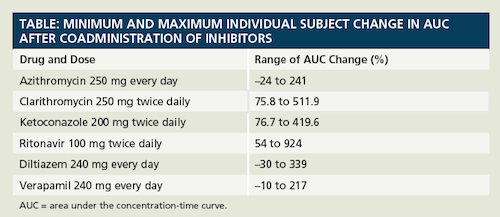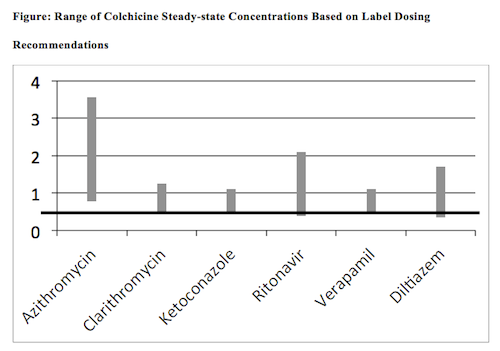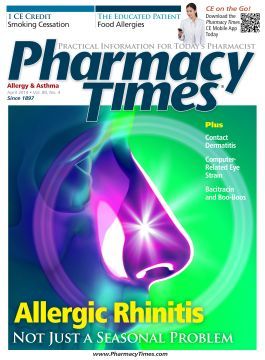Publication
Article
Pharmacy Times
Variability in Drug Interactions: Does a One-Size Dose Adjustment Fit All?


Several of our articles have discussed the fact that interpatient response to a drug interaction is often large. It is not uncommon to see 6-fold differences in the magnitude of response to an interaction during controlled trials. This degree of variability was noted in drug interaction studies done with colchicine in healthy subjects.1 Colchicine is a substrate for CYP3A4 and P-glycoprotein (P-gp). Elevated colchicine plasma concentrations can lead to diarrhea, myalgia, fever, and blood dyscrasias. The incidence and severity of some colchicineinduced adverse reactions appear to be dose/concentration related.2 As expected, many reported cases of colchicine toxicity occur in patients taking long-term colchicine for gout prophylaxis who receive concomitant inhibitors of CYP3A4 or P-gp.3 In addition, because colchicine is partially eliminated by the kidneys, patients with creatinine clearance <30 mL/min should have their doses reduced.1 Patients with even modest renal impairment may be at greater risk of colchicine toxicity when exposed to CYP3A4 or P-gp inhibitors. If possible, inhibitors should be avoided in patients taking colchicine who have any degree of renal failure.
Drug Interaction Studies
The manufacturer of colchicine studied the effects of several inhibitors on the kinetics of a single, oral 0.6-mg dose of colchicine. Based on the results of these studies, recommendations for colchicine dosage adjustments for these and other drugs were included in the labeling. The normal dosage for gout prophylaxis is 0.6 mg twice daily. When the magnitude of change observed in the studies was assessed, the dosage of colchicine was left unchanged (azithromycin), reduced to 0.3 mg twice daily (verapamil, diltiazem), or reduced to 0.3 mg daily (clarithromycin, ketoconazole, and ritonavir).

The Table shows the minimum and maximum individual subject change in the area under the concentration time curve (AUC) following coadministration of the inhibitors. In addition to providing insight on the variability in response, these ranges represent the range of outcomes that can be expected from the interaction. For example, subjects receiving clarithromycin 250 mg twice daily had colchicine AUC values that increased by 76% to over 500% compared with colchicine administration alone.

Using these ranges of response, we estimated the average maximum and minimum plasma concentrations that would result if the label dosage recommendations were applied to patients with the same range of change in the AUC as seen in each study. The estimated average colchicine plasma concentration that would result from a dose of 0.6 mg twice daily in normal subjects is about 1 ng/mL. As shown in the Online Figure, the range of colchicine plasma concentrations resulting from the label recommendations varies from 0.35 to 3.6 ng/ mL. On examination of the results for each of the 6 drugs, it is apparent that the results differ and that if the recommendations were applied to the subjects in the study, some would have subtherapeutic colchicine concentrations, while others may experience toxicity. Azithromycin, for which no dose adjustment is recommended, displays the largest potential increase above preinteraction concentrations. The recommendations for ritonavir and diltiazem produce fairly equal colchicine concentrations above and below the preinteraction concentration, while clarithromycin, ketoconazole, and verapamil appear to result in lower colchicine plasma concentrations than those observed with normal dosing and no interacting drugs.
End Note
These data demonstrate the variability in patient response to a pair of interacting drugs. These data were developed in healthy subjects and may not reflect the magnitude of variation in patients. The recommendations provided in labeling or published studies should be considered as guidelines. Following the guidelines may result in patients who still develop drug toxicity or who fail to achieve adequate efficacy. It is important that appropriate monitoring be conducted when patients receive interacting drugs, despite dosage adjustment. This becomes even more imperative for drugs such as colchicine that have narrow therapeutic ranges and significant toxicity.4
Drs. Horn and Hansten are both professors of pharmacy at the University of Washington School of Pharmacy. For an electronic version of this article, including references, if any, visit www.hanstenandhorn.com.
References:
- Colcrys [package insert]. Deerfield, IL: Takeda Pharmaceuticals America, Inc; 2012.
- Terkeltaub RA, Furst DE, Bennett K, et al. High versus low dosing of oral colchicine for early acute gout flare. Arthritis Rheum. 2010;62:1060-1068.
- Wilbur K, Makowsky M. Colchicine myotoxicity: case reports and literature review. Pharmacotherapy. 2004;24(12):1784-1792.
- Colchicine: serious interactions. Prescrire Int. 2008;17:151-153.







